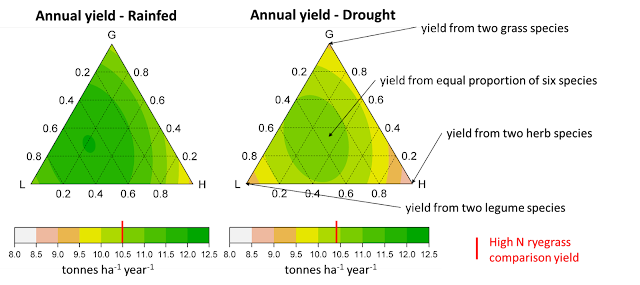Based on a Teagasc press release from August 2021
Six-species swards outperformed perennial ryegrass monocultures and were considerably more resistant to drought. New research from Teagasc, Johnstown Castle and Trinity College Dublin shows that multi-species mixtures receiving 150 kg/ha/year of nitrogen fertiliser, out-yielded perennial ryegrass monocultures receiving double that amount of fertiliser (300 kg/ha/year). Increases in plant diversity up to six species in intensively managed grasslands reduced the impact of drought, and produced more yield with less fertiliser.
Higher-diversity
lower-input mixtures produced higher yields than low-diversity high-input
monoculture
Averaged across
the two years of the trial, mixtures with all six species produced the highest
yields, and yielded more than the best of the six monocultures. Under rainfed
conditions, the mixture with equal proportions of all six species at sowing (produced
11.8 tonnes/ha/year) outperformed the best-performing monoculture (produced 10.5
tonnes/ha/year).
Even after increasing fertiliser rates on perennial ryegrass in monoculture, it did not yield as much as the highest diversity mixture.
Getting more from less: the annual yield of six-species mixtures (6-species) of grasses, legumes and herbs out-performed the perennial ryegrass monoculture and was not lower than the perennial ryegrass monoculture with a high level of nitrogen fertiliser.
Higher diversity mixtures
produced similar yields under drought as other comparisons under rainfed
conditions
As expected, total
annual yields were generally reduced by the experimental drought. Nevertheless,
the higher-diversity lower-input mixtures under unfavourable drought conditions
achieved similar yields to those from the low-diversity, high-input comparison
under favourable rainfed conditions. This indicates the potential for
multi-species mixtures to mitigate the effect of more variable weather
conditions on grassland yields across the whole year.
Dr John Finn, a
senior researcher at Teagasc’s Environment Research Centre at Johnstown Castle
said; “The need for research on drought in Irish grasslands has become all too
obvious in recent years, and that need will only increase in the coming
decades. The use of multi-species is one strategy to improve the resilience of
grassland production.”
Dr Caroline
Brophy, Associate Professor at Trinity College Dublin, said; “It is crucial
that we reduce nitrogen fertiliser inputs to improve the sustainability of Irish
agricultural grasslands. Using innovative statistical approaches, we show that
multi-species mixtures provide a solution to reduce fertiliser usage, without
compromising on grassland production.”
What proportions of
grasses, legumes and herbs are the best?
The most
productive swards were a combination of species from the three functional
groups of grasses, legumes and herbs. With legume proportion between 30 and
70%, yields were better than the best monoculture.
More diverse mixtures of grasses, herbs and legumes had higher (darker green) annual yields (tonnes/ha/year-). Results averaged across two years under rainfed conditions (left) with a 9-week summer drought applied (right). Yields from plots with only herbs (H), legumes (L) and grasses (G) monocultures are indicated in the corner points. The red line on the yield scale indicates yields from perennial ryegrass with 300 kg/ha/year of nitrogen. As one moves from the centre toward G, L, and H, the change in colour indicates the changes in yields with increases in the proportion of grass, legume and herb, respectively.
Teagasc Walsh
Scholar Guylain Grange, who conducted the experiment said; “Multi-species
mixtures can be a practical, farm-scale solution for intensive grassland production
with lower nitrogen fertiliser input, and can mitigate the risk associated with
summer droughts due to climate change. Further research at Teagasc is investigating
the use of multi-species mixtures under grazed conditions.”
Further information:
This research
is reported in the Journal of Applied Ecology and available online as an Open
Access article: https://besjournals.onlinelibrary.wiley.com/doi/abs/10.1111/1365-2664.13894
This research
was made possible by a Walsh Scholarship award by Teagasc. Guylain Grange
conducted the experiment at Teagasc’s Environment Research Centre at Johnstown
Castle, Wexford, and is a PhD student at Trinity College Dublin. Dr Caroline Brophy (Trinity College Dublin) and Dr John Finn (Teagasc) supervised
the research.



Very interesting
ReplyDelete